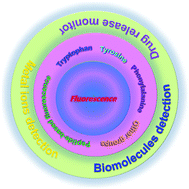A review on recent advances in amino acid and peptide-based fluorescence and its potential applications
Abstract
Fluorescence is widely used to detect functional groups and ions, and peptides are used in various fields due to their excellent biological activity. In recent years, research on fluorescent amino acids has intensified, especially with the natural fluorescent amino acids such as tryptophan (Trp), tyrosine (Tyr) and phenylalanine (Phe). They use their respective fluorophores to undergo π–π transition under excitation with light of a particular wavelength, and then release a large number of photons, which produce fluorescence. Thus, they are widely used as building units to enhance the fluorescence properties of other molecules. Peptide-based fluorescence technology has expanded the research in the field of biochemistry. Peptide-based fluorescence involving fluorescent amino acids not only retains the biocompatibility of peptides, but also relies on their fluorescent groups to enhance the fluorescent properties of the peptide itself, breaking the original limitations and connecting different fields to complement each other. This review summarizes the luminescence mechanism and fluorescent properties of the natural fluorescent amino acids and focuses on the fluorescence emission of peptides embedded with these fluorescent amino acids or fluorophores. Finally, we summarize the applications of peptide-based fluorescence in sensing drug release, metal ions and biomolecules, and present new challenges and expectations for the future development in this field.

- This article is part of the themed collection: 2021 Focus and Perspective articles


 Please wait while we load your content...
Please wait while we load your content...